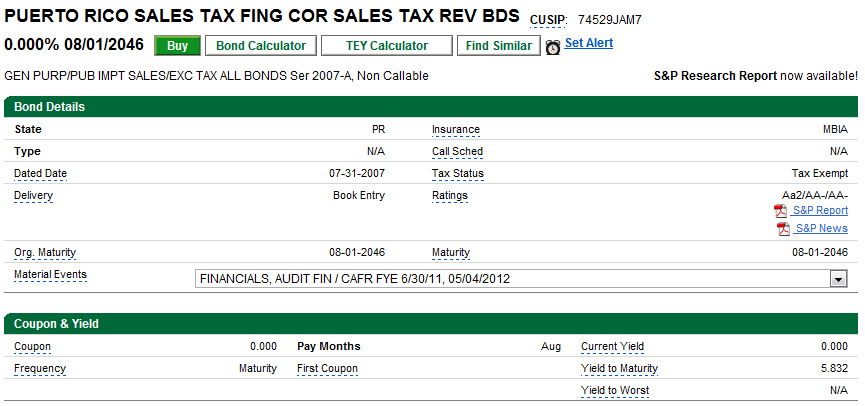Zero Coupon Bond Pricing and Characteristics
Post on: 8 Апрель, 2015 No Comment

This article briefly outlines the characteristics of a zero coupon bond, their advantages, and some of the factors that influence their value.
The fixed income securities known as zero coupon bonds are a good option for investors who want a certain return over a period. Like a “Compound GIC,” the investor in a zero coupon bond does not have any cash flows prior to maturity. This means an investor knows his return in advance if he holds a zero coupon to maturity.
“Zero Coupon Bond” or “Strip Bond” are bonds that are created by “stripping” a normal bond into its constituent parts: the “Coupons” and “Residual” or “Resid”. An investment dealer will first buy a bond and then “strip” it. The individual coupons are the semi-annual interest payments due on the bond prior to maturity. The residual is the principle payable at maturity. Both coupons and residuals are “zero coupon bond” or “zero”. Investment Dealers exist to make a profit so the strips or zeros are sold to investors. The dealers obviously make a healthy profit on stripping bonds.
The profit is created by the way the “Yield to Maturity” (YTM) of a bond is calculated. The YTM of a normal bond is the same for all the bond’s cash flows. On the other hand, each strip bond is valued using the YTM of a comparable bond, a 5 year bond for a 5 year coupon and a 30 year bond for the 30 year residual. The sum of the parts is usually worth more than the whole bond was prior to stripping. A “steep yield curve,” or big difference between short and long bond yields, make stripping very profitable.
What is a Zero Coupon Bond?
A zero coupon bond are fixed income securities that are created from the cash flows that make up a normal bond.
The cash flows of a normal bond consist of the regular interest or “coupon” payments that take place over the term of the bond, and the principal repayment that occurs at maturity of the bond. For example, the cash flows of the Government of Canada 8% bond with a maturity date of June 1, 2023 are:
Related Article
- $4 every December and June 1st up to and including June 1, 2023, representing 4% of the $100 par value
- $100 on June 1, 2023, representing the repayment of the principal or par amount of the bond.
Taken individually, each of these payments is an obligation of the issuer, in this case, the Government of Canada. The process of “stripping” a bond involves depositing bonds with a trustee and having the trustee separate the bond into its individual payment components. This allows the components to be registered and traded as individual securities. The interest payments are known as “coupons” after their source of cash flow, and the final payment at maturity is known as the “residual” since it’s what’s left over after the coupons are stripped off. Both coupons and residuals are known as zero coupon bonds, or “zeros.”
Once a bond has been stripped, a trustee directs the appropriate amount of the interest or maturity payment to the security holders. The holder of a zero coupon receives the par amount of the particular term of the zero that she holds. For example, an investor holding $100,000 par amount of the December 1, 2001 coupon would receive $100,000 on that date.

Conceptually, a zero coupon security is just like a treasury bill or “T-Bill.” The investor pays something up front in exchange for a promise to receive $100 on the maturity date.
Take our example of the coupons and residual generated by stripping the Canada 8% of 2023. If we start on December 1, 1996 the first two payments are identical to a 6-month and 1-year T-Bill. An investor would receive $100 on June 1st and December 1st for each $100 par amount she purchased of these terms of coupons.
Calculating the Price of a Zero Coupon Bond
The basic math is easy. What should an investor pay for the 1-year coupon? If the investor demands a 4% return over a one-year period, she should pay something around $96 for the $100 maturity value (actually $96.154 since we’re starting at less than $100).
As a rough cut, forgetting the compounding of interest (interest-on-interest) and the conversion to semiannual yields, we know that 5.6% for 5 years is 28%. This means if we pay something around $72 (100-28) on December 1, 1996 for the $100 coupon due on December 1, 2001, we will earn something around 30% over the period or 6% a year.
Pulling out our trusty bond calculator, we can actually do the calculation. At a semi-annual yield of 5.6%, the price works out to be $75.91. At a semiannual yield of 6%, the price works out to be $74.44.
Why You Should Think About Buying a Zero Coupon Bond
Of course, nothing is as easy as it seems. The yield of a zero coupon bond is different than the yield of a normal bond of the same issuer.
This difference of “spread” reflects the economics or profits available to investment dealers from “stripping” activities and the supply and demand for a zero coupon bond. There is also a difference in yield between coupons and residuals, which reflects the larger size of residuals and the economies of trading compared to the many smaller coupon positions or “lines.”
Those considerations aside, A zero coupon bond can be a useful option for investors who like knowing they will receive a certain amount of set income at a certain time, without having to spend too much time thinking about their portfolio.
(Visited 151 times, 150 visits today)














